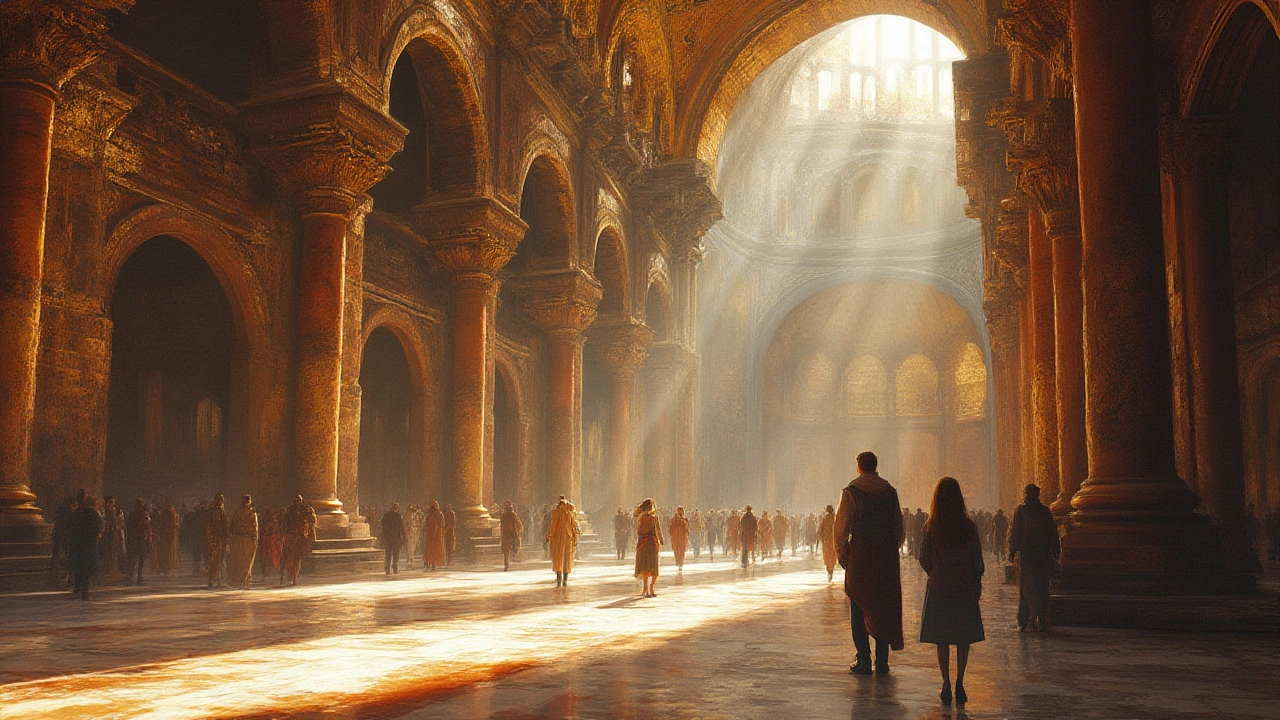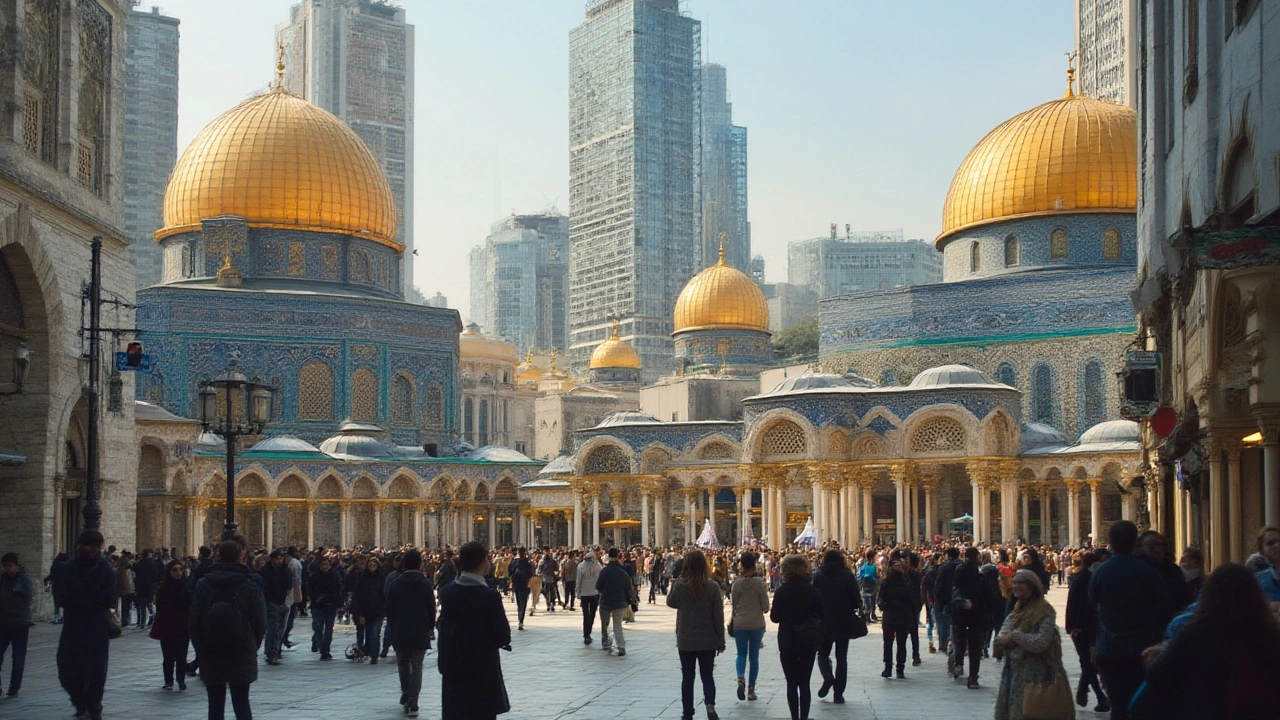Byzantine Architecture: The Synthesis of Classical and Eastern Styles
 Jul, 14 2025
Jul, 14 2025
When you think of ancient architecture, soaring columns and marble statues probably jump to mind. But step inside a Byzantine basilica, and the story changes. It floods you with gold, color, and dizzying domes. This isn’t just architecture—it’s a mashup that rewrote the rules and left fingerprints on everything from Eastern Orthodox cathedrals to modern city skylines. Even if you’re more into surf than spires like me in Wellington, Byzantine architecture pulls you in with its strange mix of logic and magic.
The Roots: From Rome to Byzantium
To get Byzantine architecture, you’ve got to wind back to the Roman Empire’s last days. The old empire was a melting pot—think ancient Rome, plus bits of Greece, Egypt, Persia, Syria, and North Africa. In the fourth century, Emperor Constantine shifted the center of action from Rome to Byzantium (later renamed Constantinople, now Istanbul). This wasn’t a minor move. Suddenly, they had a city sitting at the crossroads between Europe and Asia, soaking up every cultural influence on offer. The city’s rulers wanted their buildings to show off not only Roman power but also their worldly new position.
Roman building techniques stuck around: big brick domes, rounded arches, and thick walls. That foundation was solid, thanks to innovations like Roman concrete, but the look began to morph almost right away. Romans loved orderly columns and big, rectangular basilicas. Once Byzantium became the new capital, architects let go of some symmetry and started playing with math and mysticism. It wasn’t just ‘build it up’—now it was ‘make it shimmer,’ ‘make it feel otherworldly.’
One of the crucial shifts involved shifting the classic basilica layout. Traditional Roman churches were long and rectangular—think St. Peter’s in Rome. Byzantines started squashing that layout into a square, then dropped a giant dome right over the center. This wasn’t just for beauty; it let them pack more people under one roof, united by the light pouring through windows at the base of the dome.
There’s no Byzantine style without a borrowed bag of tricks: Greek columns, Persian tilework, Syrian squinches (those nifty structures that help a round dome rest on a square room), and Egyptian gold leaf. These recipes came together like a flamboyant cake. If you think architecture can’t be dramatic, the Hagia Sophia will blow your mind. When it opened in 537—built by Emperor Justinian I—folks said you could see light dripping from the dome, as if it was floating above worshippers’ heads. No one had seen anything like it.
Domes That Define a Skyline
The dome is the rockstar of Byzantine architecture. Roman domes were impressive, sure, but Byzantine domes shifted the game. Instead of a heavy hemisphere, they went for lighter, shallow domes perched atop tall drums peppered with windows. This let in floods of light, which bounced off gold-tiled mosaics and made the ceiling look like it was floating. Some architects called it “building with light.”
But let’s get a bit technical—how did they pull this off? The secret weapon was the pendentive, a triangle-shaped engineering marvel that transforms a building’s square base into a suitable seat for a round dome. This sounds academic, but if you’ve walked into a big sports stadium or visited a modern shopping mall with a dome, you’ve seen distant echoes of this move. The massive central dome of Hagia Sophia—over 31 meters in diameter—was only possible because engineers figured out how to distribute the weight onto four chunky arches and let the walls do less heavy lifting.
Domes weren’t plopped down for show either; there was symbolism at work. For Byzantine Christians, the dome represented the heavens. Gathered underneath, people shared a slice of paradise on earth. This spiritual pull was powerful enough that dome-building fever spread across the empire’s sprawling lands—from Ravenna in Italy to Thessaloniki to the monasteries of Mount Athos. Peek at St. Mark’s Basilica in Venice and you’ll spot five domes smothered in golden light, all thanks to this Byzantine DNA.
And here’s a cool fact: the brilliance wasn’t limited to stone and glass. Byzantine builders lined their domes with golden mosaics, turning ceilings into blindingly shiny storytelling tools. Imagine flickering candlelight and morning sun ramping up the drama, blurring the line between inside and out, earth and sky.
Practical tip? If you’re ever restoring an old house or building a modern home and you want a wow factor, look into coved ceilings or domed light wells. Even a small-scale dome over a room—paired with some gold paint or shiny glass tile—pays tribute to this ancient obsession with light, volume, and drama, in a way that modern fans of natural light totally get.

Mosaics, Light, and the Art of Storytelling
Step inside a Byzantine chapel, and what grabs you isn’t the walls—it’s what’s on them. Art wasn’t an afterthought. The mosaics covering walls and domes fuel the sense of wonder and serve as the Instagram feed of their era. These glass and stone tiles—sometimes as tiny as a fingernail—captured gospel stories, mystical scenes, and portraits of saints beaming back at you.
Mosaic-making was an obsessive process. Each piece had to be hand-shaped, colored, and pressed into fresh plaster at just the right angle so it would catch sunlight or candlelight. Artists even offset the tiles a bit for that signature sparkle. Gold leaf was sandwiched between layers of glass to create a glow that felt supernatural, even in the gloomiest weather. Some art historians suggest these mosaics weren’t just decoration—they set out to bend the physical world, making solemn spaces feel like spiritual launchpads.
If you’re hunting for the best surviving examples, hit up Ravenna in northern Italy. The Basilica of San Vitale (circa 547) is a treasure chest of Byzantine mosaic magic: check out the famous mosaic of Emperor Justinian decked out in imperial purple, flanked by soldiers, clergy, and even a courtier holding a golden communion plate. Each scene is loaded with detail, symbolism, and surprisingly bright color despite more than a millennium of grime and earthquakes. Some art conservationists say the mosaics' sticking power comes down to how Byzantines mixed their glass—lots of recycled broken glass, plus new minerals for color, which produced a candy-like dazzle still obvious today.
And let me speak straight: you can totally steal this vibe for your space. Want to punch up a bathroom or kitchen backsplash? Mosaic tile patterns, or even DIY kits inspired by Byzantine designs, are on the rise. Mix glass, gold, and colored tile for a dramatic, light-catching surface that actually hides dirt and smudges better than plain tiles. Whether you go the full empress or just a strip of pattern, you’re channeling a bit of ancient genius.
Legacy Beyond Its Borders
Some folks think Byzantine architecture is just a flavor of church design, but its real impact is global. When the Ottomans took Constantinople in 1453, they adapted Byzantine innovations wholesale. Check out the Blue Mosque in Istanbul or Russia’s St. Basil’s Cathedral—full-on Byzantine domes, lanterns, and striped columns echo back across continents.
Byzantine methods didn’t vanish; they just evolved. The distinctive cross-in-square plan, super high ceilings, and mosaic artwork spread not just to Orthodox churches in Greece or Russia but also to distant places—like the Saint Sava Temple in Belgrade finished in the 20th century. Even some old New York and London churches nod to it. Ukrainian and Greek immigrants brought the love of squat domes and detailed mosaics with them to new countries;
A weird twist? Art Deco architects in the 1920s and 1930s borrowed gold tiles and stylized patterns right out of Byzantine playbooks. Next time you see a glitzy movie palace or a posh hotel lobby with shiny, intricate ceilings, remember the roots. Engineers and designers today riff on those ancient tricks—using skylights, reflective surfaces, and decorative tile to pull in light and create drama in even the most compact urban homes.
If you want a tip for seeing the “Byzantine touch” without traveling to Istanbul: peek at Google Earth for roof shapes, look for those telltale domes and clusters of arches in city skylines, or take a virtual tour of the Hagia Sophia (now open again as a mosque, and still jaw-dropping). For the design-curious or the practical renovator, there’s inspiration everywhere—from choosing stained glass for your front door to adding gilded highlights to an art project.
Let’s be honest: Byzantine architecture didn’t totally stick to one script. It morphed, borrowed, and blended style with substance, religious awe with real-world skill. That’s what keeps it relevant—whether you’re gazing up at a thousand-year-old dome or thinking about how to fill your living room with a little more light and story.